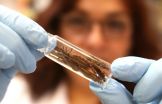(Press-News.org) A newly published research study by U.S. Forest Service researchers demonstrates that the social vulnerability indices used in climate change and natural hazards research can also be used in other contexts such as disease outbreaks. Authors of the article include Forest Service Southern Research Station (SRS) researchers John Stanturf, Scott Goodrick, Mel Warren, and Christie Stegall, and Susan Charnley from the Forest Service Pacific Northwest Research Station.
Published in the online journal PLOS ONE, the study illustrates how census and household survey data, when mapped at the district level, can help highlight the locations of households and populations most vulnerable to disease outbreaks such as the Ebola virus disease. The results can be used to identify vulnerability hotspots where resources could be allocated to address issues such as water quality, food insecurity, and access to medical care that make it harder for communities to deal with disease outbreaks and other disasters.
"It might seem strange that a group of Forest Service researchers are writing about Ebola," says Stanturf, senior scientist with the SRS Center for Forest Disturbance Science. "We developed the social vulnerability index for a USAID climate change vulnerability assessment of Liberia, so we had the data and were interested in seeing whether it could be helpful when the Ebola epidemic struck in 2014."
Assessing social vulnerability to the potential effects of disease epidemics and other stressors is particularly challenging in Sub-Saharan African countries such as Liberia because social and economic data below the national or regional levels are typically very limited. In Liberia the civil war that lasted from 1989 to 2003 resulted in the destruction of both data and the infrastructure to collect it. At the same time, social vulnerability assessments are needed to guide government and international agencies in efforts to reduce vulnerability to disease epidemics and other stressors and to strengthen the ability of communities to adapt.
To build the social vulnerability index, the researchers used 18 variables from Liberia's 2008 census to serve as potential indicators of five dimensions of poverty - economic, health, political, sociocultural and protective. "We know that vulnerability and poverty are not the same, but the two are often highly correlated," says Stanturf. "Poverty reduces people's ability to cope with, recover from, or adapt to external stresses that affect their livelihood and well-being, thus increasing their social vulnerability."
The researchers mapped social vulnerability at the district level, clustering Liberia's districts and ranking them from most to least vulnerable. They found that the three clusters of most vulnerable districts contain 40 percent of the country's rural population, well over 1 million people. Correlating their findings with data from the World Health Organization on the incidence of Ebola cases, the researchers were able to identify "vulnerability hotspots" where social vulnerability combined with lack of access to medical care led to Ebola infections and death that might have been prevented if more resources had been available.
"Despite the limitations we cite in the article, we believe that the classification and map we produced represent a first step in better understanding the relationship between social vulnerability and disease in Liberia, pinpointing where specific improvements in livelihoods and living conditions may be most needed," says Stanturf. "In the broader sense, we've demonstrated how our approach, which has mainly been used in the context of climate change and natural hazards, can be adopted in situations such as disease outbreaks where there's a need for rapid, quantitative social vulnerability assessments at multiple scales."
INFORMATION:
For more information, email John Stanturf at jstanturf@fs.fed.us.
Access the full text of the article: http://www.srs.fs.usda.gov/pubs/49174
Headquartered in Asheville, NC, the Southern Research Station comprises more than 120 scientists and several hundred support staff who conduct natural resource research in 20 locations across 13 southern states (Virginia to Texas). The Station's mission is "...to create the science and technology needed to sustain and enhance southern forest ecosystems and the benefits they provide." Learn more about the Southern Research Station at: http://www.srs.fs.usda.gov/.
WEST LAFAYETTE, Ind. -- A new study reveals a pressing need to better understand water use in America's rivers, with implications for drought-stricken regions of the country.
Findings from the study showed that virtually all of the water entering the Wabash River in Indiana during summer months is withdrawn and then returned to the waterway.
"In a nutshell, in the summertime we generally use what is equivalent to the entire volume of the Wabash River so that by the time the river reaches the confluence of the Ohio River, the water in the Wabash on average has been through ...
GeoSpace
Mercury's movements give scientists peek inside the planet
The first measurements of Mercury's movements from a spacecraft orbiting the planet reveal new insights about the makeup of the solar system's innermost world and its interactions with other planetary bodies, found a new study recently accepted in Geophysical Research Letters.
New research calls for rethinking of New Zealand's Alpine Fault
The major fault line of New Zealand's Alpine Fault, which runs almost the entire length of the South Island, has been assumed to be a near vertical crack. However, ...
A deadly parasite that causes Chagas disease is widespread in a common Texas insect, according to a new study by University of Texas at El Paso (UTEP) researchers. The finding suggests that the risk of Texans contracting the disease may be higher than previously thought.
The parasite Trypanosoma cruzi (T. cruzi), which causes Chagas disease can be transmitted to humans by blood-sucking insects known as "assassin bugs" or "kissing bugs." Unlike mosquitoes that transmit malaria through the bite, kissing bugs drop feces on the subject while filling up with blood. The feces, ...
A low resting heart rate in late adolescence was associated with increased risk for violent criminality in men later in life, according to an article published online by JAMA Psychiatry.
Low resting heart rate is related to antisocial behavior in children and adolescents. Low resting heart rate (RHR) has been viewed either as an indicator of a chronically low level of psychological arousal, which may lead some people to seek stimulating experiences, or as a marker of weakened responses to aversive and stressful stimuli, which can lead to fearless behavior and risk taking. ...
Among patients 70 years or older who underwent elective surgery, major complications contributed significantly to a prolonged length of hospital stay while delirium contributed significantly to several adverse outcomes, including length of stay and hospital readmission, according to a study published online by JAMA Surgery.
Major postoperative complications and delirium contribute independently to adverse outcomes and high resource use in patients who undergo major surgery; however, their interrelationship has not been well examined. Understanding the risks of adverse ...
A follow-up of nearly 60,000 women who received a synthetic vaginal mesh sling for the treatment of stress urinary incontinence finds the risk is low for needing a second surgery for mesh removal or revision (about 1 in 30 women ten years after surgery), according to a study published online by JAMA Surgery.
Female stress urinary incontinence (SUI) is a common condition that is often treated with surgery when conservative management options are unsuccessful. An estimated 1 in 7 women will undergo surgery for SUI during their lifetime. Synthetic mesh slings are the most ...
BOSTON -- Researchers from the Aging Brain Center at the Institute for Aging Research (IFAR) at Hebrew SeniorLife confirm that delirium is a significant and independent contributing factor to poor postsurgical outcomes in older adults. Findings published in JAMA Surgery suggest that the combination of major postoperative complications and delirium demonstrate a strong combined effect on adverse outcomes in older adults undergoing major surgery.
Of all inpatient operations in the U.S. in 2007, 36% were performed on patients 65 years of age or older, and that number is ...
Capsaicin, the compound responsible for chilis' heat, is used in creams sold to relieve pain, and recent research shows that in high doses, it kills prostate cancer cells. Now researchers are finding clues that help explain how the substance works. Their conclusions suggest that one day it could come in a new, therapeutic form. Their study appears in ACS' The Journal of Physical Chemistry B.
About 10 years ago, researchers reported that capsaicin can kill prostate cancer cells in mice while leaving healthy cells unharmed. But translating that dose to humans would require ...
An isolated, iron-rich bay in the heart of East Africa is offering scientists a rare glimpse back into Earth's primitive marine environment, and supports theories that tiny microbes created some of the world's largest ore deposits billions of years ago.
According to University of British Columbia (UBC) research published this week in Scientific Reports, 30 per cent of the microbes in the Democratic Republic of the Congo's Kabuno Bay grow by a type of photosynthesis that oxidizes (rusts) iron rather than converting water into oxygen like plants and algae.
"Kabuno Bay ...
Smoking has been shown to have drastic consequences for lifespan and disease progression, and it has been suggested that cigarette exposure may impact the risk of death and disease via its acceleration of the aging process. Not all smokers experience early mortality, however, and a small proportion manage to survive to extreme ages.
Using long-lived smokers as their phenotype, the authors of a study published today in The Journals of Gerontology, Series A: Biological Sciences & Medical Sciences identified a network of SNPs (a DNA sequence variation occurring commonly ...

